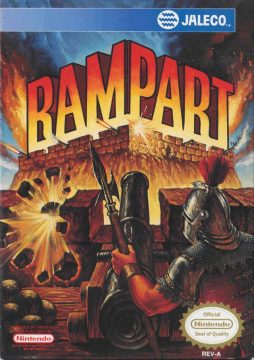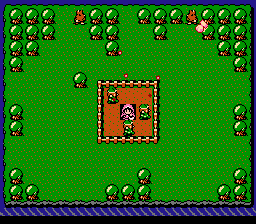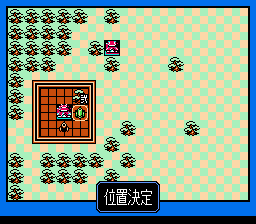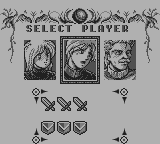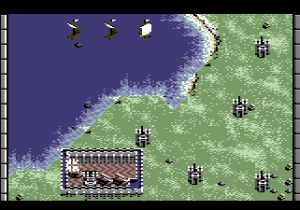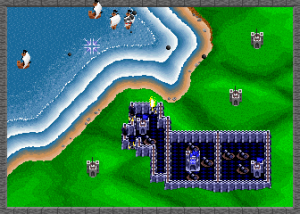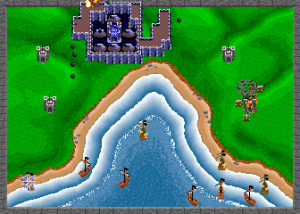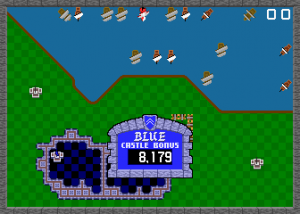More than any other form of gaming, arcade games tend to stick to trends. Ever since Space Invaders, arcade developers always try to follow the hottest thing on the market. This trend is why it’s always important to notice the games that do their own thing entirely. Atari’s Rampart is like nothing else of its time, and even now, there’s hardly much else like it at all. About the only real way to describe is like some kind of cross between Tetris and a very early tower defense, and even that description doesn’t feel entirely accurate. At its core, it’s an interesting mixture of puzzle game and a shooter, and while it’s got a high skill ceiling, it’s a generally successful experiment.
When you start a new game of Rampart, you’ll first select one of several battlefields you’ll be attempting to conquer, and from there, which castle on the battlefield you want to take control of first. The game will surround that castle with walls, which claims it and the ground around it as your territory. While the game will give you a small square of territory for free, you’ll need to fence in more space on the map to claim more, so that you have more room to build cannons. After you’ve placed some cannons, you’ll be thrust right into the game’s battle phases. In these phases, you take control of a cursor you can move around the screen at will, and hitting the fire button will fire off one of your cannons, which you’ll use to blast at enemy ships.
Your cannons have some quirks you’ll need to work around to achieve maximum destruction. Your shots take a few seconds to actually reach the water, and you’ll need to be good at leading your target to hit the constantly moving ships. It’s also important to count your shots, since you can only have as many cannonballs on screen at once as you have cannons. You’ll never want to fire more shots at a ship than it needs to be destroyed, since you don’t want to have to wait for your cannons to reload when you need to use them. After a short period of time, the battle phase will come to an end, with new ships showing up on the map to replace the ones you took out.
After the battle phase comes the building phase, in which you have a short time to fix the gaps enemy shots make in your walls, and if you’re fast, claim more of the map as your own. Here, your cursor controls one of several Tetris-esque pieces that you’ll need to place and rotate somewhere on the map to build walls. Your goal in the building phase is to be sure that at least one castle on the map is within your territory, and failure to do this means you’ll have to spend a credit. Any cannons that aren’t surrounded by walls are also unusable, severely limiting your firepower. If you’re especially fast, however, you can surround other parts of the board to claim it as your territory, which you can use in future phases to place more cannons. If this territory includes another castle, since this’ll give you some bonus points and a safety net.
The ships still play a part in the battle phases, with some causing you more problems than others. Double-masted ships will release little tanks called ‘grunts’ onto the field if they hit the shoreline. Grunts can destroy walls and undefended castles alike during the battle phase, and they’ll move around during the building phase and prevent you from building over them. Grunts can be destroyed either with cannon fire or by surrounding them with walls, but dealing with them means you’ll be distracted from other threats. Red ships fire cannonballs that’ll leave craters wherever they land that can’t be built over, and there’s no way to get rid of them besides wait several rounds. You’ll want to prioritize destroying the red ships and double-masts over the regular ships, but the game tends to spawn so many of both at once that you’ll almost never be able to entirely prevent them from screwing you up.
The building phase is probably the toughest part of the game, more so than the battle phases. Much like Tetris, you’ll often never seem to get the exact piece you want. It’s also fairly easy to doom yourself by putting the wrong block in the wrong place, since you can’t build over what you’ve already placed. You also can’t build over water, which means that picking a castle next to the shore means that your shots don’t have to travel as far, but building around them is a little tougher. Once you’ve survived the building phase, you’ll place some more cannons and begin another battle phase. You conquer a level once you’ve cleared enough battle phases, although the fact that the game won’t tell you how many you need means that winning feels somewhat arbitrary.
The game’s biggest problem is that the difficulty curve feels too steep. The first territory is a breeze, but after that, the game basically throws you right into the deep end. Even if you can clear the screen of ships, the game will spawn seven or so more during the next building phase, so it often feels like you can never really keep up. There are certain tricks and tactics you can use to delay your defeat, but it often feels like there’s no real way to keep up with the forces the game throws at you. The worst part of all is that the game only allows you to continue so many times, so you’ll never get too far into the game unless you know every trick and tactic for continued survival.
There’s also a multiplayer option for up to three players, which is arguably the game’s real draw. Instead of firing at enemy ships, this mode has up to three players blasting away at each other’s walls. The rest of the mode is about the same as always, although you no longer have to deal with craters or grunts. You do, however, have to deal with your own walls spontaneously combusting, even if there’s nobody actually controlling the other players. The usual cycle continues until you hit a maximum number of rounds, in which case the winner is determined by score. You’re also eliminated if you lose three credits, which is far more likely nowadays than running out of quarters. Should all the players stay in long enough that the losers aren’t allowed to continue, there’s a scene of the losing players about to be beheaded. Thanks for that, Atari Games.
The game’s graphics aren’t fancy, but they work well enough. There’s an interesting visual touch where the building and cannon phases have a simple tactical view, which transitions into a high-detail view when a battle phase begins. The sound is also serviceable, if not fantastic, with the only real standout track being the hectic theme that plays during the building phases. The game does make use of a lot of digitized speech, with some guy doing his best to put on a British accent calling out when to start and stop firing, as well as a few game hints.
The two halves of the game come together just well enough it can draw you back again and again, although you’ll probably leave every attempt feeling annoyed. There’s a fantastic concept in there, which is why it’s a real shame it’s never had a sequel or a reboot that might bring in just a bit more polish. At the very least, there’s plenty of ports to be found, both of the original arcade version and for various consoles, some of which add on some interesting extra features. While most of these ports can’t support the three player multiplayer of the arcade, a majority of them have multiple difficultly levels. Unfortunately, they bring over the limited continues from the arcade version as well, so it’s a rough trade.
The Atari ST version looks and plays pretty accurately to the arcade, with its biggest flaw that the battle phases suffer from massive slowdown. It also supports the ST’s mouse, which works great for the battle phases, but is too fiddly to rely on during the building phases. It’d be a pretty decent port with nice music, if it weren’t for how slow it was. The Amiga version is almost identical, aside from having somewhat better audio.
The Commodore 64 version also supports three players, with the third player using the keyboard. It’s a little more sluggish than most other ports, but otherwise plays pretty well. Since C64 joysticks typically only have one button, rotating is done by holding the fire button down and using the joystick, which works fairly well.
The DOS version is the most accurate of all the ports, to the point where it can support three players. At least, if you can figure out some way to get three people around one computer. This version also features an Enhanced mode, which introduces new foibles to the game. If you have three cannons, you can trade them in for the ability to place a balloon, which will convert an enemy ship or an opponent’s cannon to your side. The single player Enhanced mode also adds houses to the map, which will spawn a grunt if you build over them. It’s a fantastic port that outclasses a great many arcade to DOS ports of the time.
The Famicom version was actually brought out by Konami, and the music and art style make that very clear. The structure has been changed so that there’s several different campaigns of varying difficulties, each with its own theme. The easiest campaign has a Little Red Riding Hood setting, the medium has a fantasy theme, and the final campaign takes place in ancient Japan. Each campaign is split into several levels, which are now cleared either by hitting a certain point target, or by bringing the number of enemies down to zero. Some levels also have special conditions, like having to surround a certain object on the map to win, or having enemies that turn into obstructing tombstones when destroyed. The whole thing has a different feel to it, one with a slower pace, and it’s generally a little easier on the whole. It even offers you unlimited continues and a password feature, and considering how tough the arcade version could get, it’s very appreciated.
The NES version is a straight conversion of the arcade, with the only real fault being that it’s not as pretty as the original version. It doesn’t have any other real faults, so it’s a pretty serviceable port. Unfortunately, it’s not nearly as interesting as the Famicom version. At the very least, it has a very silly manual, if you consider that sort of thing a plus.
The Super Nintendo version takes the most liberties from the original, but it’s almost always better for it. The goal has been changed so that instead of trying to survive a random number of waves, you win a level when every ship on screen has been destroyed. Enemy ships will slowly respawn between phases, however, so you need to have a cannon arrangement that’ll let your shots outpace their respawn rate. It’s a nice change that helps emphasize the game’s puzzle element a little more, especially since this version features passwords if one particular level defeats you. It leads to a much more approachable game, one where you actually have a goal you have to plan towards, instead of just a constant deluge of enemies that will inevitably overwhelm you.
This version also features a “Super Rampart” mode that introduces even bigger changes to the gameplay. This mode features a brand new set of maps, all of which are so massive that they can’t be contained on a single screen. Ships now attack from all sides of the map, and you’ll occasionally make use of new extra-large pieces to fill out your territory faster. You’ll also rarely encounter a new “boss” ship, fitted with multiple cannons that each take multiple hits each to destroy. As a tradeoff, if you have three cannons to spare, you can trade them in for the balloon from the DOS port, or for a massive supercannon that can take out a ship in one shot. While it might not be the most accurate of ports, it’s a far more polished game that’s easier to approach, even if not everybody will appreciate the gratuitous Mode 7 effects.
The Master System version is probably one of the weakest ports, which is surprising given the edge in hardware it had over the NES. Graphically, it’s closer to the arcade version, but it lacks music entirely, with only some very DOS-esque bleeps for sound. Given the sort of things a half-decent composer could do with the MS’s sound chip, it’s pretty inexcusable. It also runs a lot more sluggishly, especially during the multiplayer mode.
The Genesis version looks and plays fairly accurately, with the only real gameplay complaint being that the cursor feels somewhat stiff, at times. It’s almost missing all the music, except for an entirely different track during the building phases, for reasons we will never truly understand.
The Lynx version has to use smaller sprites and sacrifice visual detail to make everything fit on one screen, but manages to stay readable. It’s an excellent port, complete with all the digitized speech. While it doesn’t do anything too new with the gameplay, it does have a nice animated intro and some artwork not seen in other versions.
The Game Boy version is one of the stranger versions of the game, although not quite to the extent of the Famicom version. You’re given the choice of three different characters upon starting a new game, which supposedly determines the strength of your cannons and defenses. Unfortunately, it’s hard to notice what actual difference this makes in gameplay. This version also has you shooting at soldiers, knights, and moving towers. They don’t behave much differently than the ships, except that they move around more randomly, which makes them far tougher to actually hit. To make up for the Game Boy’s small screen, your castle and the surrounding land is kept on one screen, while all the enemies are contained on a separate screen you have to scroll the cursor into.
It works well enough, since you never really look at your walls while you’re shooting. The lack of screen space hurts far more during the building phases, however. There’s also rock walls you can shoot to destroy them, if you can afford the distraction, and some of these surround extra castles and cannons. Although it’s far from an accurate port, it still works out pretty well for a handheld system. The Japanese version replaces the generically medieval character portraits with anime-styled ones, and the enemies with fantasy monsters like roving skulls and hooded wizards.
The Game Boy Color version closely resembles the Lynx version, and plays just about as accurately. It sounds even closer to the arcade version, due to using a massive amount of sampled sound and speech. It’s all a little grainy, but given the hardware, that’s forgivable. It’s also got the most difficulty options of all the ports, with the easiest setting letting you clear the entire game in about five minutes. If you ever wanted to see what Rampart‘s single screen ending looked like, now’s your chance.
The game is featured on the Midway Arcade Treasures collection for the PS2, Xbox, Game Cube and PC, as well as on the Midway Arcade Origins collection for PS3 and Xbox 360. These are accurate emulation of the arcade version and nothing else.
The standalone PlayStation 3 version of the game was a straight emulation of the arcade version, although it did offer an online multiplayer mode. Unfortunately, it’s been unavailable for purchase for years.
Comparison Screenshots


